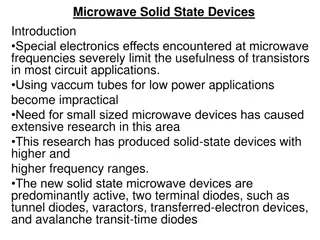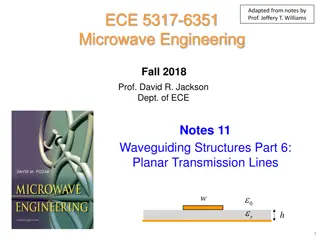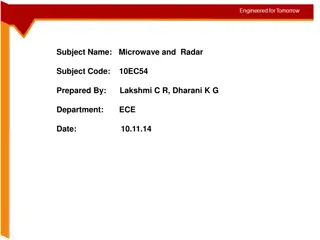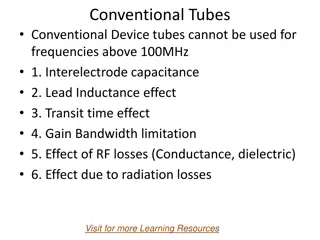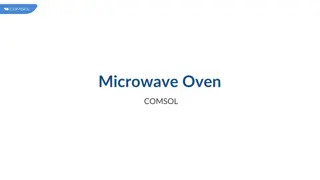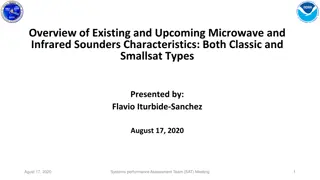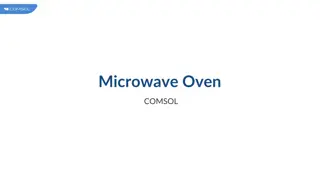
Benefits of Microwave Ablation in Oncology Treatments
Explore the advancements and applications of Microwave Ablation in oncology, including its physics, benefits, and comparison with RF ablation. Learn about the companies in this field and the potential rise of the microwave ablation market by 2020.
Uploaded on | 1 Views
Download Presentation

Please find below an Image/Link to download the presentation.
The content on the website is provided AS IS for your information and personal use only. It may not be sold, licensed, or shared on other websites without obtaining consent from the author. If you encounter any issues during the download, it is possible that the publisher has removed the file from their server.
You are allowed to download the files provided on this website for personal or commercial use, subject to the condition that they are used lawfully. All files are the property of their respective owners.
The content on the website is provided AS IS for your information and personal use only. It may not be sold, licensed, or shared on other websites without obtaining consent from the author.
E N D
Presentation Transcript
The Benefits of Microwave Ablation Presented by: Symple Surgical Inc.
The Benefits of Microwave Ablation The goal of this session is to: Introduce the concept of Microwave Ablation Basic Physics of Microwave and other Radio Frequency Energy Sources Review some of the therapies & fields Microwave Ablation is being used in Many of which have FDA approval Compare the capabilities Microwave Ablation to more widely accepted RF Ablation
What is Microwave Ablation? Microwave Energy is a subset of the Radio Frequency Spectrum, similar to RF Ablation Energy Transmitted via insulated coaxial cable Delivered through an antenna/emitter Common Medical Microwave: = 915 MHz, 2.45 MHz For reference: RF: = 460 kHz Creates an electromagnetic-field for dielectric heating RF Ablation requires conduction of alternating electrical current
What is Microwave Ablation? Dielectric Heating occurs when the molecules, as part of human tissue, become polarized by an alternating electromagnetic field. Rapid rotational movement, referred to as molecular dipole rotation, of the molecules inside the material cause collisions with neighboring molecules. The ensuing result is frictional heat. The heating zone is controlled by several factors including: Power, Frequency, Antenna Design, and the material properties in the near-field of the antenna.
Common Applications for Microwave Ablation Microwave Ablation is a relatively new therapy used primarily in the field of Oncology. Current Microwave Ablation therapies include: Tumor Ablation Renal Adrenal Liver Lung Kidney Prostate Soft Tissue Ablation Amenorrhea Bone Metastases Heart Arrhythmias Cosmetic Treatments
Microwave Ablation Companies Currently, there are only a few companies with developed products in the field of Microwave Ablation: BSD Medical NeuWave Medical MedWaves Microsulis Medical (AngioDynamics) ValleyLab Covidien Due to its high success rate in treatment of most cancers, the microwave ablation market is estimated to rise very quickly by 2020. Miramar Labs Vision Medical ProstaLund Symple Surgical Inc. 2016 - Markets and Markets Research Report, Ablation Devices Market to
Advantages of Microwave Ablation Microwave Ablation has several advantages for treatment compared to more common ablation therapies including: Faster Heating1 Larger Heating Zone2 More Uniform Heating Zone3 Less dependent on Tissue Properties3 No grounding pad or 2nd pole necessary Tissue contact is not necessary Independent of wall pressure
Microwave Ablation vs. RF Ablation Figure 1: Temperature measurement taken in vivo Swine Kidney, 5mm from applicator. 1 Faster Heating
Microwave Ablation vs. RF Ablation Figure 2: Typical RF (left, 1 cm diameter) and Microwave (right, 2.1 cm diameter) ablations created at a power of about 40 W for 10 min in ex vivo porcine lung. 2 Larger Heating Zone
Microwave Ablation vs. RF Ablation More Uniform Heating
Citations 1. Brace CL. Radiofrequency and microwave ablation of the liver, lung, kidney and bone: what are the differences. Curr Probl Diagn Radiol. 2009 May-Jun; 38(3): 135-143. 2. Andreano A, Huang Y, Meloni Mf, Lee F, Brace C. Microwaves create larger ablations than radiofrequency when controlled for power in ex vivo tissue. Medical Physics. 2010 Jun; 37(6): 2967- 2973. 3. Laeseke P, Sampson L, Frey T, van der Weide D, Lee F, Brace C. Thermal ablation in kidneys: microwave ablation with a triaxial antenna results in larger zones of coagulation than rf. Radiological Society of North America Annual Meeting; Chicago, IL. 2006 4. Lubner M, Brace C, Hinshaw JL, Lee F. Microwave Tumor Ablation: Mechanism of Action, Clinical Results and Devices. Journal of Vascular Interventional Radiology. 2010 Aug; 21(8 Suppl): S192- S203.









